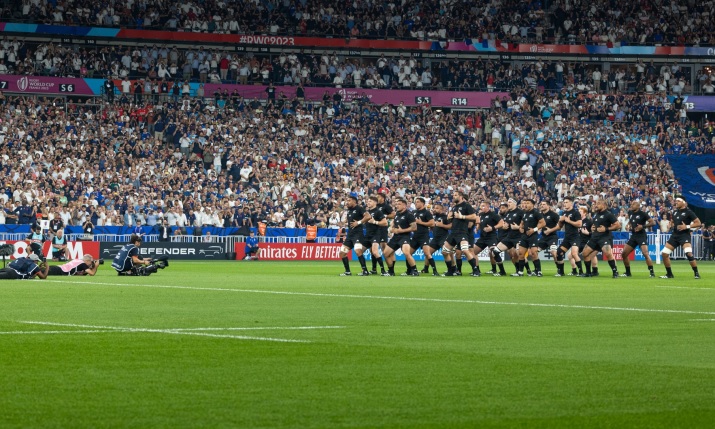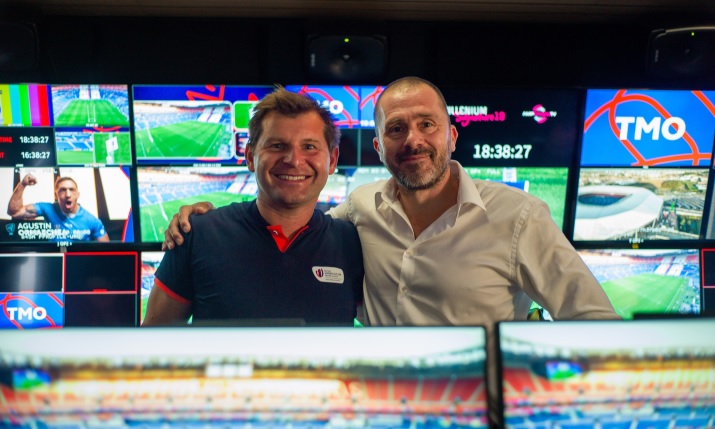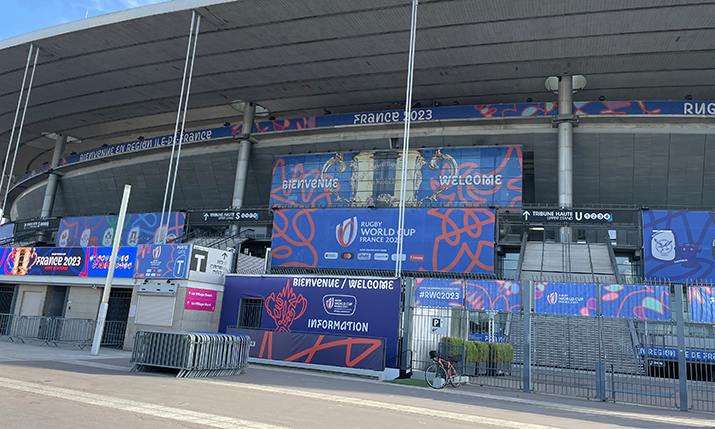Live from the Rugby World Cup 2023: “Immersive and emotional” cinema-style shots bring fans closer to the action

Reflecting a growing trend in sports broadcasting, cine-style cameras have been added to the Rugby World Cup production set-up for 2023, bringing a dramatic look to certain parts of the host broadcast match coverage.
Through the use of DSLR cameras with Prime lenses, the production team at Host Broadcast Services (HBS) can capture shots of fans and players with a shallow depth of field that are considered to be more immersive, showcasing the raw emotions of the matches for the viewers back home.
Sony FX3 cameras are being used for this tournament. Here, Julien Bertin, executive producer for HBS at Rugby World Cup 2023, picks up the story.
“We want to get closer to the players,” he says. “Rugby is a very popular sport with players and with fans, and we wanted to get the fans closer to the action and closer to those players because we feel there’s a real rugby community. And when I say community, it goes from a club president to a six-year-old kid. We really feel everybody’s on the same level. We wanted to get that across.”
“We can get wide-angle shots of tries happening rather than trying to get in close. We’ve captured some really nice slo-mos of tries being scored with the whole stadium background and the team going over the try line.”
This manifests itself in a couple of ways, he continues.
“So, when they arrive at the stadium, we have dramatic close-up shots of the players as they walk in, in slow motion. It’s an amazing way to tee up the game, to say, for example, this is Johnny Sexton and he is really focused. It’s simple things. You shoot it at 200 frames per second and suddenly the footage has another dimension.
“In the tunnel before kick-off, we go in close. In the first game of the World Cup, players were already singing in the tunnel, getting hyped up. We captured that with a cine-style camera. That worked really well. With fans, again we use slo-mo to capture the raw emotion.”

Telling the story: Executive producer for HBS Julien Bertin with director Daniel Hudson in Lyon
Steve (better known as Strve, following a now legendary spelling mistake earlier in his career) Jamieson, World Rugby executive producer, was unsure about the use of these cameras pre-tournament. But he is now a convert.
“When a try is scored, I encourage the commentators not to say anything but to let the crowd in and then we just cut to a big cine-style close-up of a fan just screaming at the camera. There’s no point in talking over it. The picture tells the story.
“I’ll be honest,” he says. “Before this World Cup, I wasn’t a fan of cine-style because I’ve seen it badly used at other events. People running around, shots going in and out of focus. So I wasn’t sure. But we did a trial in Madrid on a World Rugby Pacific Four Series game and we got some nice stuff out of it.”
“At the beginning of the tournament, the person wasn’t in focus because he or she was moving. So we went back to the drawing board and put the cameras back behind the dead ball line and just had a wide angle. And that got us some amazing slo-mos.”
The use of cine-style cameras at France 2023 has changed since the first match, he adds.
“On the first weekend, some of our guys were running onto the field trying to get the player coming back [after scoring a try]. Personally, it just didn’t work for me. So we looked again at how we could do that. If the operators are on the main camera side, if they are running in from that side, they’d get in shot. So we had to think about them coming in from a different angle.
“So we’ve changed as the tournament has gone on. I think the best shots are the fan shots and the team arrival shots. But we can also get some nice wide-angle shots of tries happening rather than trying to get in close. We’ve captured some really nice slo-mos of tries being scored with the whole stadium background and the team going over the try line.”

Bertin acknowledges that it’s not easy to get the shots right using a cine-style camera.
“The lower you go [with focal lengths], the shallower the depth of field you get. This is what makes the shot so interesting and unusual [for sport]. At the same time, it isolates the person you’re trying to capture. As long as that person is halfway still, it’s easy to work around that, and this is why, when we are in the tunnel and the players arrive, we always have the same distance as we walk [with the camera] so that all works.
“But when we go on to the field after they score a try, we don’t know if are they going to walk back or if they are they going to run back. We want to capture the player’s face and the emotion. It could, again, bring the viewers closer to the action. But the margin for error is very small. When you get it right, it’s amazing. But it is very hard to get it right with those lenses.
“Eight or nine times out of ten, at the beginning of the tournament, the person wasn’t in focus because he or she was moving. So we went back to the drawing board and put the cameras back behind the dead ball line and just had a wide angle. And that got us some amazing slo-mos that are usually used in the second slo-mo run.
Bertin hopes that in the future, when using these types of cameras, operators will have an easier job of capturing a moving target.
“We want to be able to track someone when they are moving in a less predictable way. DSLR manufacturers are working hard on that,” he suggests.
The 2023 Rugby World Cup continues in France until Saturday 28 October.
Read more:
- Live from the Rugby World Cup 2023: World Rugby and HBS offer up additional content for rights-holding broadcasters
- Live from the Rugby World Cup 2023: Consistency and simplicity are key for host broadcast match coverage
- Live from the Rugby World Cup 2023: Referee mic plays crucial role in capturing atmosphere and ambience

